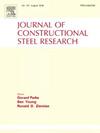Post-fire residual mechanical properties of high strength Q960 steel considering tensile stress in fire
IF 4
2区 工程技术
Q1 CONSTRUCTION & BUILDING TECHNOLOGY
引用次数: 0
Abstract
This study explored the influence of stress levels on the residual mechanical properties of Q960 high strength steel after exposure to temperatures ranging from 300 °C to 800 °C. While many studies on post-fire mechanical properties of high strength steel neglect the presence of stress during heating and cooling, this research addresses this gap by conducting tensile tests under three pre-tension ratios. The results show that, in the temperature range of 300 °C–500 °C, constant tensile stress enhances the residual yield strength and ultimate strength of Q960 steel, with ultimate strength increasing by up to 7 %. However, at temperatures above 600 °C, tensile stress adversely affects these properties. Furthermore, the residual elastic modulus of Q960 steel remains largely unaffected by tensile stress. Comparisons with Q690 high strength steel reveal that pre-tension has a weaker influence on the residual yield strength of Q960 steel but a stronger detrimental effect at higher temperatures. Additionally, compared to S960 high strength steel (nominal yield strength: 960 MPa), Q960 steel demonstrates superior residual ultimate and yield strengths after high-temperature exposure, while S960 exhibits greater sensitivity to temperature changes in terms of elastic modulus. Compared to other 960 MPa high strength steels, Q960 CTUS (Cold-Formed Thick-Walled Ultra-High-Strength Steel) shows an increase in residual yield strength when exposed to temperatures between 300 °C–600 °C. These findings highlight the critical role of stress levels and temperature in determining the post-fire mechanical performance of high strength steel.
求助全文
约1分钟内获得全文
求助全文
来源期刊

Journal of Constructional Steel Research
工程技术-工程:土木
CiteScore
7.90
自引率
19.50%
发文量
550
审稿时长
46 days
期刊介绍:
The Journal of Constructional Steel Research provides an international forum for the presentation and discussion of the latest developments in structural steel research and their applications. It is aimed not only at researchers but also at those likely to be most affected by research results, i.e. designers and fabricators. Original papers of a high standard dealing with all aspects of steel research including theoretical and experimental research on elements, assemblages, connection and material properties are considered for publication.
 求助内容:
求助内容: 应助结果提醒方式:
应助结果提醒方式:


